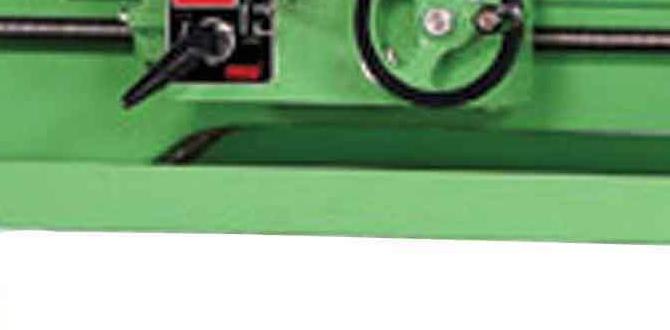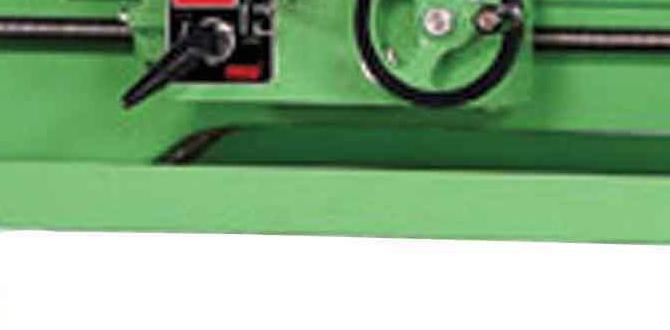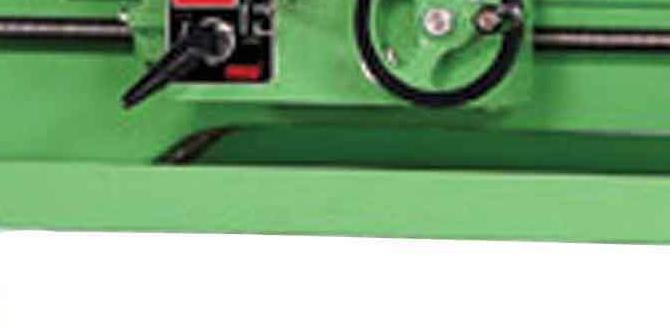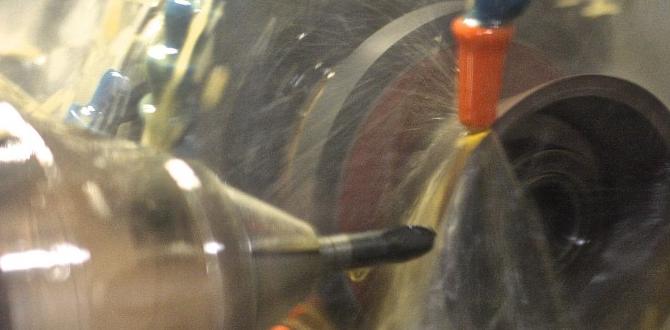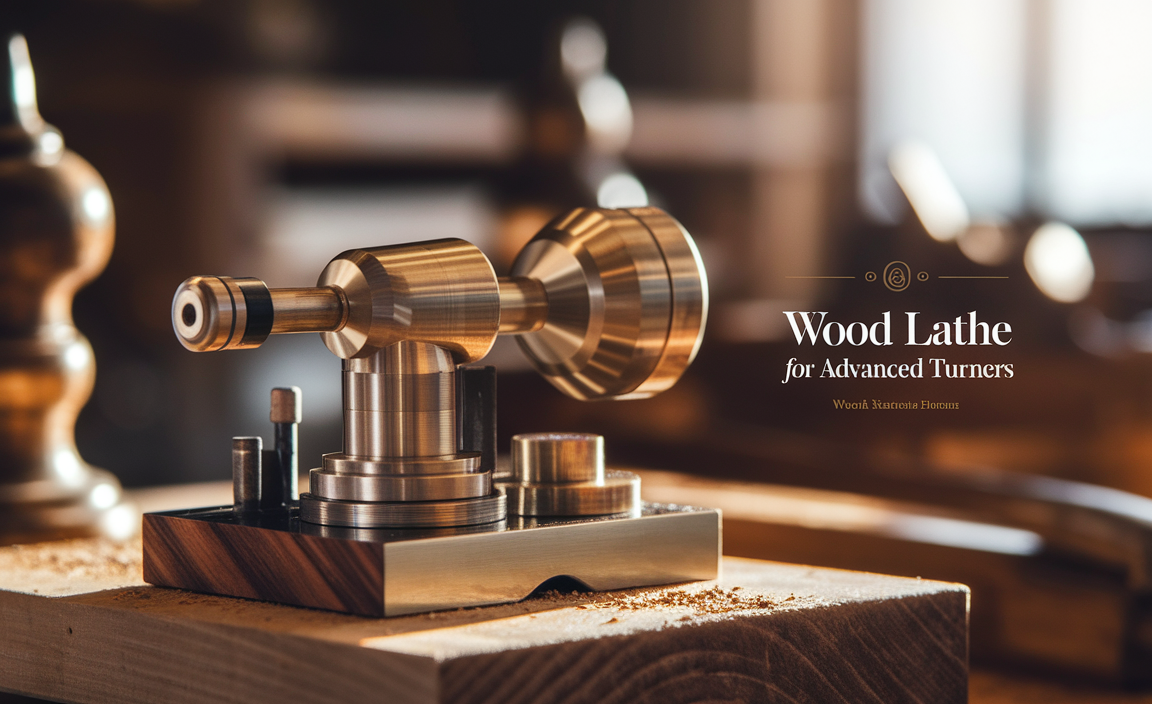A wood lathe variable speed motor kit is a game-changer for any woodturner, allowing precise control over spindle speed for safer, cleaner, and more enjoyable projects. It’s an essential upgrade that unlocks new creative possibilities and makes learning much smoother.
Ever feel like your wood lathe has a mind of its own when it comes to speed? Maybe it’s a bit too fast for delicate work or a bit too slow to get a good finish. This common frustration is something many woodturners face. You’re not alone if you’ve wished for more control. The good news is, there’s a fantastic, often overlooked solution: a variable speed motor kit. This isn’t just a fancy add-on; it’s a genuine upgrade that can transform your turning experience, making it safer, more efficient, and a whole lot more fun. Stick around, and we’ll explore why this upgrade is so brilliant and how it can help you conquer those speed-related headaches.
Wood Lathe Variable Speed Motor Kit: Genius Essential Upgrade
When you first get into woodturning, a basic lathe can be a rewarding tool. But as your skills grow and your projects become more ambitious, you’ll start to notice the limitations of a fixed-speed motor. Constant belt changes to adjust speed can be time-consuming and frankly, a bit of a pain. It’s like trying to drive a car with only one gear – you can get around, but it’s far from optimal. This is where a variable speed motor kit steps in, offering a level of control that feels like a superpower for your lathe.
Think about it: different wood types, different project stages, and different turning operations often demand different spindle speeds. A roughing gouge might do its best work at a lower speed, while a detailer or a sanding operation might benefit from higher RPMs. Without variable speed, you’re constantly compromising or spending precious time fiddling with belts. A variable speed kit means you can dial in the exact speed you need, instantly, with the simple turn of a knob or a digital display. This precision not only makes your work easier but also significantly enhances safety, especially when working with larger pieces or trickier grain patterns.
In this guide, we’ll dive deep into what a variable speed motor kit is, why it’s such a smart investment for woodturners of all levels, the different types available, and what to consider before you buy one. We’ll also walk through the general process of installation and highlight the many benefits you can expect. Get ready to unlock a whole new level of control and creativity for your woodturning projects!
Why a Variable Speed Motor Kit is a Must-Have Upgrade
The limitations of fixed-speed wood lathes become apparent pretty quickly. Most entry-level or older lathes run on a multi-pulley system. To change speeds, you have to stop the machine, open up the covers, manually move the belt to a different set of pulleys, and then reassemble. This process is not only tedious but also introduces potential safety risks if not done carefully.
A variable speed system, on the other hand, gives you the flexibility to adjust the revolutions per minute (RPM) of your lathe’s spindle on the fly. This is a game-changer for several reasons:
- Enhanced Safety: Lower speeds are crucial when starting a new piece, especially if it’s unbalanced or irregularly shaped. Slowing down reduces the risk of kickback or the piece coming loose. Conversely, higher speeds are generally safer for sanding and fine finishing.
- Improved Woodworking: Different turning tools perform best at specific speeds. A roughing gouge might tear out wood at high speeds, while a detail spindle gouge needs speed to make clean cuts. Variable speed allows you to match the tool, wood, and task for optimal results.
- Versatility: Whether you’re turning tiny pens or large bowls, a broad range of speeds is invaluable. You can easily switch between tasks – from roughing out to fine shaping to sanding – without stopping and manually adjusting belts.
- Easier Learning Curve: For beginners, controlling speed is a vital skill. Variable speed makes it simple to experiment safely and understand how different speeds affect wood during turning and sanding.
- Time Savings: Eliminating the stop-and-start belt-changing process frees up your time to focus on the creative aspects of turning.
Understanding Wood Lathe Speeds (RPM)
Revolutions Per Minute (RPM) refers to how many times the spindle of your lathe rotates in one minute. The speed you choose is critical and depends on several factors:
- Wood Hardness and Density: Softer woods can generally be turned at higher speeds than hardwoods. Very dense, exotic woods might require slower speeds to prevent overheating or tool glazing.
- Diameter of the Workpiece: Larger diameter pieces should always be turned at lower speeds. As the diameter increases, the surface speed (the speed at which the wood’s surface is moving past the tool) increases dramatically, even at the same RPM. A common rule of thumb is to keep the surface speed below 5,000 feet per minute, but for beginners, staying well below that is wise.
- Type of Operation:
- Roughing Out: For initial shaping of green or awkward logs, use the lowest safe speed.
- Spindle Turning: For items like table legs or chair spindles, you’ll typically use medium to high speeds once the piece is balanced.
- Bowl Turning: Starts slow for roughing, then speeds up gradually as the shape becomes more symmetrical and balanced.
- Detailing: Sharp tools at appropriate speeds can achieve fine cuts.
- Sanding: Generally, higher speeds are used for sanding to efficiently remove material and achieve a smooth finish.
- Tool Sharpness: Sharper tools can often handle slightly higher speeds without burning or tearing.
- Lathe Stability: A sturdy lathe can handle higher speeds more safely than a wobbly, lightweight one.
A fixed-speed lathe often has only 3 or 4 speed settings, forcing compromises. A variable speed system, however, allows you to fine-tune your RPMs, giving you the perfect setting for each specific situation.
Types of Wood Lathe Variable Speed Systems
There are a few main ways to achieve variable speed on a wood lathe:
1. Electronic Variable Speed (EVS) Kits
This is the most common and sought-after method for upgrading an existing lathe or for factory-built lathes. An EVS kit typically replaces or augments your existing motor and pulley system with a variable speed controller and often a new motor. The controller uses electronics to adjust the motor’s speed.
How they generally work:
- A variable frequency drive (VFD) or a similar electronic controller is installed.
- This controller takes the incoming AC power and adjusts its frequency and voltage sent to the motor.
- By changing the frequency, the motor’s rotational speed is directly controlled.
- A dial or digital display on the controller allows you to set the desired RPM.
Pros:
- Wide speed range, often from very low to very high RPMs.
- Instant speed changes without stopping the machine.
- Generally smooth operation.
- Can sometimes offer more power at lower speeds (depending on the motor and controller).
Cons:
- Can be more expensive than other methods.
- Installation can be more complex, potentially requiring basic electrical wiring knowledge.
- Requires mounting the controller unit somewhere convenient.
2. Reeves Drive (Mechanical Variable Speed)
Less common on modern wood lathes but found on some older or industrial machines, a Reeves drive is a mechanical system that uses two adjustable cone pulleys. As one pulley expands, the other contracts, effectively creating an infinitely variable belt path and thus, speed change.
How they generally work:
- Two large pulleys, each made of two halves that can move closer or further apart.
- A special, wide belt runs between these pulleys.
- A handwheel or lever adjusts the spacing of the pulley halves, moving the belt up or down the cones to change diameter and speed.
Pros:
- Mechanical simplicity (no complex electronics).
- Can provide a good range of speeds.
- Durable.
Cons:
- Requires the machine to be stopped to change speeds.
- Can be bulkier and heavier.
- Maintenance of the drive mechanism itself is required.
- Not typically available as an aftermarket upgrade kit for most wood lathes.
3. Inverter/VFD Systems (DIY or Integrated)
This is essentially a type of Electronic Variable Speed. Many lathes are now manufactured with integrated VFD systems. For those upgrading older lathes, a VFD is often the core component of an EVS kit. You can purchase standalone VFDs and motors to create your own custom EVS setup if you’re comfortable with wiring and fabrication.
Pros:
- Precise control over motor speed.
- Can often reverse motor direction.
- Soft start feature can be useful.
- Many modern VFDs are designed for specific motor types (e.g., 3-phase motors) and can be adapted for wood lathes.
Cons:
- Requires identifying compatible VFD and motor.
- Installation involves electrical connections and potentially mounting the VFD.
- May require converting single-phase power to a 3-phase motor if using a common 3-phase VFD setup, or using a VFD designed for single-phase input and output.
For the purpose of an “upgrade kit” for a hobbyist, Electronic Variable Speed (EVS) systems, often relying on VFD technology, are the most prevalent and practical choice. These kits are designed to be retrofitted onto lathes that originally had fixed-speed pulley systems.
Key Features to Look For in a Variable Speed Kit
If you’re looking to upgrade your lathe, not all variable speed kits are created equal. Here’s what to consider:
- Speed Range: Look for a kit that offers a broad RPM range. A good range might be as low as 100-300 RPM for large bowls and as high as 3,000-4,000+ RPM for sanding. Check specified minimum and maximum RPMs.
- Power Output (HP/Wattage): Ensure the kit’s motor (or the motor it’s designed to control) matches or exceeds your lathe’s original power. Upgrading an underpowered lathe might require a more robust motor.
- Ease of Installation: Some kits are designed as direct bolt-in replacements, while others require more fabrication. Read reviews and check instructions if available.
- Control Interface: Is it a simple dial? A digital display with buttons? Consider what will be most intuitive and easy to use in your workshop. Digital displays offer greater precision.
- Durability and Build Quality: Read reviews about the reliability of the controller and motor. You want something that will last.
- Reversibility: Some EVS systems allow you to reverse the direction of spindle rotation. This can be useful for certain finishing techniques or when using specific tools.
- Brand Reputation and Support: Stick with reputable brands that offer good customer support and warranties.
- Compatibility: Crucially, ensure the kit is designed for your specific lathe model or the general type of lathe you have (e.g., swing capacity, mounting).
Table: Common Variable Speed Kit Components
| Component | Description | Typical Function |
|---|---|---|
| Variable Speed Controller (VFD/Inverter) | The “brain” of the system. Converts input AC power to adjustable frequency and voltage for motor speed control. | Allows you to select and maintain desired RPM. |
| Motor | Often a new motor designed for EVS use, or the original motor is rewired to work with the controller. | Provides rotational power to the lathe spindle. |
| Control Panel/Dial | The user interface. Usually a knob or buttons with a display. | Enables the user to adjust and view the spindle speed. |
| Mounting Hardware & Wiring | Brackets, screws, and electrical wires specific to the kit. | Secures components and connects them electrically. |
| Belt & Pulleys (Sometimes) | May include a new belt or pulleys designed to work with the new motor and controller. | Transmits power from motor to headstock. |
Installation: What to Expect (General Overview)
Installing a variable speed motor kit is usually a DIY-friendly project, but it can vary in complexity. Always refer to the specific instructions that come with your chosen kit. Here’s a general rundown of what’s typically involved:
- Safety First: Ensure the lathe is unplugged and disconnected from any power source before you begin. Wear safety glasses.
- Dismantle Old System: You’ll likely need to remove the existing motor, motor mount, belt guard, and potentially the belt and pulleys attached to the headstock or countershaft.
- Mount New Motor: Install the new motor (if included) or adapt your existing one using the provided mounting hardware. Ensure it’s securely fastened.
- Install Controller: Find a suitable location on your lathe or a nearby workbench to mount the variable speed controller. It needs to be accessible but out of the way of chips and dust.
- Wiring: This is the most technical part.
- Connect the incoming power (from your wall outlet) to the controller.
- Connect the controller to the motor.
- Connect the control panel/dial to the controller.
Crucial Note: If you are not comfortable with basic electrical wiring, it is highly recommended to consult with a qualified electrician or someone experienced in VFD installations. Improper wiring can damage components, pose a fire hazard, or cause electrical shock.
- Connect Motor to Spindle: Install the appropriate belt between the motor pulley and the headstock pulley. Ensure proper belt tension. For some kits, you may keep your existing headstock pulley.
- Reassemble Guards: Reinstall any necessary safety guards, ensuring they function correctly with the new setup.
- Testing: Before running at full speed, do a preliminary test at very low RPMs. Check for any unusual noises or vibrations. Gradually increase speed and monitor performance.
Tip: Many manufacturers offer installation videos or detailed manuals online. Searching for “[Your Lathe Model] variable speed conversion” can yield helpful results from other users who have tackled this upgrade.
The Benefits of Increased Control and Precision
The most significant advantage of a variable speed wood lathe is the absolute control it gives you over the turning process.
For Beginners:
- Confidence Building: Starting a new project or working with unfamiliar wood can be daunting. The ability to start at a crawl, feel how the wood reacts, and gradually increase speed builds confidence without unnecessary risk.
- Faster Skill Development: You can focus on cutting techniques, tool angles, and finishing without the constant distraction of belt changes. Experimenting with different speeds for different tools and woods becomes easy, accelerating your learning.
- Safer Practices: Understanding that you can instantly slow down or stop the lathe is a huge safety net. This is especially critical when turning off-center blanks or when getting used to the feel of interrupted cuts (like with burl wood).
For Experienced Turners:
- Effortless Workflow: Transition seamlessly from roughing to shaping to sanding. The time saved not stopping to adjust belts adds up significantly, allowing more turning time.
- Optimized Finishes: You can dial in the perfect speed for each stage of sanding, from aggressive paper to fine grits, achieving a super-smooth surface faster and more effectively.
- Handling Difficult Woods: Whether it’s a very soft wood that needs high speed for a clean cut, or a very hard wood that requires low speed to prevent burning, you have the precise control needed.
- Creative Exploration: Experiment with techniques that might be impractical on a fixed-speed lathe, like very slow chucking for intricate carving or extremely high speeds for specific polishing methods.
A Real-World Example: Bowl Sanding
Imagine sanding a large bowl. On a fixed-speed lathe, you might be stuck with a speed that’s too fast for the initial grits (leading to dust problems and uneven sanding) or too slow for the final grits (making it take forever). With variable speed, you can:</

